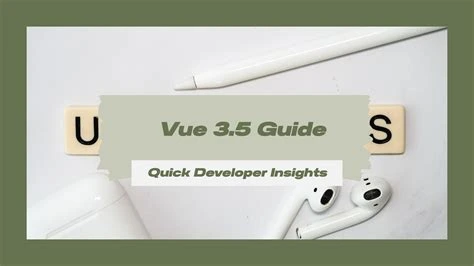Vue 3.5, released in 2024, brings a collection of substantial improvements and new features that are highly relevant for developers building large-scale or performance-sensitive web apps. Here’s a comprehensive and detailed look at what makes Vue 3.5 stand out.
Table Of Content

1. Reactivity System Overhaul
Performance and Memory Usage
- Vue’s reactivity system, which underpins how the framework tracks and updates changes in state, was rewritten to drastically optimize for both speed and memory efficiency.
- For large reactive arrays and structures, memory usage dropped by as much as 56%, and mutation or tracking operations can be up to 10x faster. This means UI interactions and data updates are now noticeably snappier, especially in complex applications or dashboards with large datasets.
- The refactored system also fixes long-standing issues related to computed property staleness and memory leaks during server-side rendering.
2. Stable Reactive Props Destructuring
- In
<script setup>, destructuring props had previously led to loss of reactivity or confusing workarounds. Vue 3.5 solves this, letting you destructure props with confidence that changes will still trigger correct updates in your component. - Default values and destructuring now work seamlessly — less boilerplate, cleaner logic, and one of the most requested quality-of-life improvements for Vue’s Composition API stylers.
3. SSR and Hydration Upgrades: Lazy Hydration
Server-side rendering developers will benefit from lazy hydration, which hydrates async or dynamically loaded components only as they become visible on screen. This can drastically improve time-to-interactive and total page performance, especially on content-heavy sites.
Developers now also have greater control over hydration warnings with the new data-allow-mismatch attribute, which suppresses expected client/server mismatch warnings for particular elements, streamlining debugging.
4. New Developer APIs
Vue 3.5 introduces several new APIs to streamline modern app development:
useId(): Quickly generate unique, consistent IDs across server and client. Crucial for SSR and accessibility (think form controls and labels).useTemplateRef(): Simplifies managing templaterefs, making it easier to access DOM elements across components and composables.onWatcherCleanup(): Effortlessly manage side-effect cleanup when watchers are invalidated or rerun. This is ideal for aborting asynchronous tasks or canceling timers without leaking resources.
5. Custom Elements Improvements
The custom elements API (defineCustomElement) gets more robust:
- App configuration support for custom elements,
- Helper APIs like
useHost()anduseShadowRoot()for fine control over Web Components, - Ability to mount a custom element without a Shadow DOM, giving authors flexibility when integrating with external styling or legacy systems.
6. Deferred Teleport
The <Teleport> component now supports a defer prop, letting you mount teleported content only after the current render cycle. For dynamic layouts or dialogs where targets might not exist immediately, this makes teleportation safer and smoother.
7. TypeScript and Tooling
TypeScript support gets another boost with improved type inference, especially for components using the latest features. This further reduces boilerplate, makes code more predictable, and improves autocompletion and error-checking during development.
Why Do These Features Matter?
Vue 3.5 is not just an incremental update; it responds directly to feedback from large-scale production apps. The focus on reactivity performance, SSR usability, developer productivity, and cross-environment compatibility makes it a compelling upgrade for modern web teams.
Performance-hungry apps (data dashboards, analytics, visualizations) will see tangible improvements.
Developers will enjoy a gentler learning curve, less boilerplate, and cleaner solutions for everyday needs.
SSR/SEO-heavy apps (blogs, e-commerce) will find hydration and custom element upgrades essential.
Who Benefits Most?
- Large projects: Performance and memory use improvements matter more as your app scales.
- SSR-heavy apps: Faster hydration, lazy loading, and hydration bugfixes yield better SEO and UX.
- Library/developer tools authors: The custom element enhancements greatly smooth interop with other frameworks and design systems.
- Teams using TypeScript: You’ll see faster, safer development with improved type inference and editor support.
Vue 3.5 demonstrates a commitment to both developer delight and real-world customer outcomes—removing long-standing pain points, boosting efficiency, and opening the path for larger and more maintainable Vue solutions.
Ready to experience the latest in Vue 3.5? We don’t just write about it—we deliver real Vue 3.5 solutions for your projects. Contact us today to make your next app faster, smarter, and more robust with the power of Vue 3.5!
Simply click the button below and fill out the form—our team will get in touch with you soon.







No Comment! Be the first one.